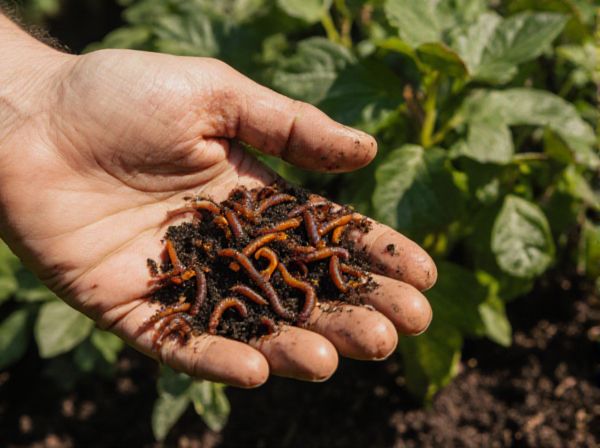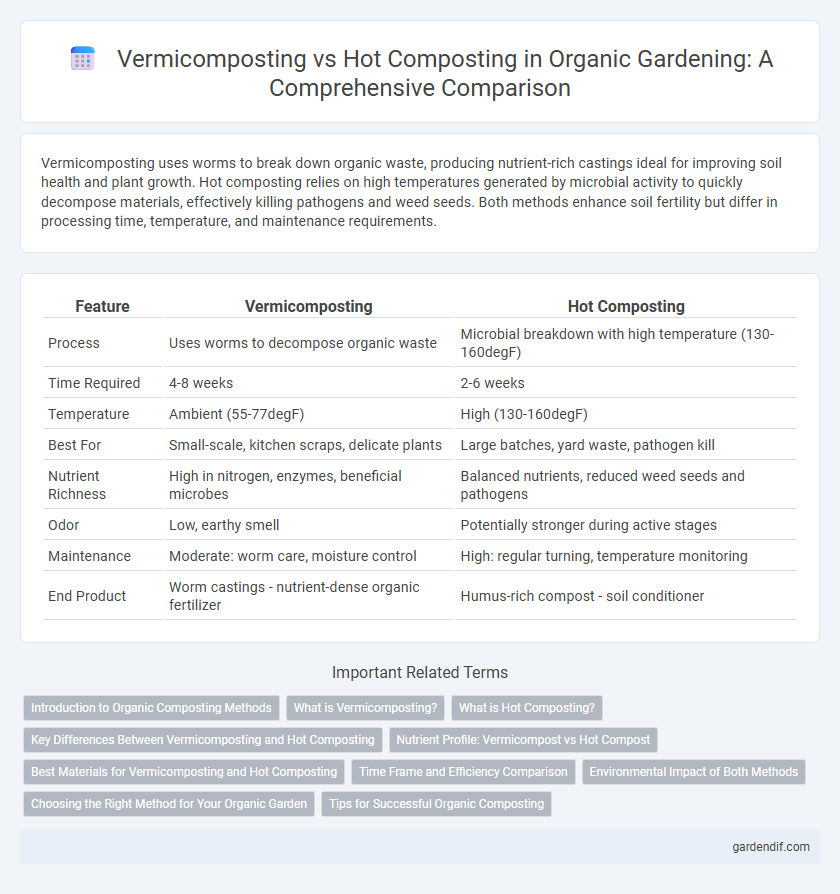
Vermicomposting vs hot composting Illustration
Vermicomposting uses worms to break down organic waste, producing nutrient-rich castings ideal for improving soil health and plant growth. Hot composting relies on high temperatures generated by microbial activity to quickly decompose materials, effectively killing pathogens and weed seeds. Both methods enhance soil fertility but differ in processing time, temperature, and maintenance requirements.
Table of Comparison
| Feature | Vermicomposting | Hot Composting |
|---|---|---|
| Process | Uses worms to decompose organic waste | Microbial breakdown with high temperature (130-160degF) |
| Time Required | 4-8 weeks | 2-6 weeks |
| Temperature | Ambient (55-77degF) | High (130-160degF) |
| Best For | Small-scale, kitchen scraps, delicate plants | Large batches, yard waste, pathogen kill |
| Nutrient Richness | High in nitrogen, enzymes, beneficial microbes | Balanced nutrients, reduced weed seeds and pathogens |
| Odor | Low, earthy smell | Potentially stronger during active stages |
| Maintenance | Moderate: worm care, moisture control | High: regular turning, temperature monitoring |
| End Product | Worm castings - nutrient-dense organic fertilizer | Humus-rich compost - soil conditioner |
Introduction to Organic Composting Methods
Vermicomposting utilizes specific earthworm species like Eisenia fetida to accelerate the breakdown of organic waste into nutrient-rich castings, promoting soil fertility through a natural biological process. Hot composting relies on thermophilic microorganisms to rapidly decompose organic materials at temperatures between 131degF to 160degF, effectively killing pathogens and weed seeds while producing mature compost within weeks. Both methods contribute significantly to sustainable organic waste recycling, enhancing soil structure and nutrient availability in agricultural and gardening applications.
What is Vermicomposting?
Vermicomposting is the process of using earthworms, primarily red wigglers (Eisenia fetida), to decompose organic waste into nutrient-rich castings that enhance soil fertility. This method operates efficiently at moderate temperatures, typically between 55-77degF, promoting microbial activity without the high heat required in hot composting. Vermicomposting is ideal for small-scale organic waste management, producing a stable, odor-free, and highly bioavailable fertilizer suitable for sustainable gardening and agriculture.
What is Hot Composting?
Hot composting is a method of organic waste decomposition that relies on high temperatures, typically between 130degF to 160degF, to rapidly break down materials. This process speeds up the breakdown of organic matter, killing pathogens and weed seeds while producing nutrient-rich compost. Proper aeration, moisture levels, and a balanced carbon-to-nitrogen ratio are essential for maintaining the heat and efficiency of hot composting.
Key Differences Between Vermicomposting and Hot Composting
Vermicomposting uses earthworms to break down organic waste at lower temperatures, producing nutrient-rich castings ideal for enhancing soil fertility, while hot composting relies on microbial activity generating temperatures of 130-160degF to rapidly decompose materials and eliminate pathogens. Vermicomposting requires consistent moisture and a stable environment, making it suitable for indoor or small-scale setups, whereas hot composting demands larger volumes of diverse organic matter and regular aeration to maintain thermophilic conditions. The slower decomposition rate in vermicomposting contrasts with the faster, high-heat process of hot composting, impacting the timeline for usable compost production.
Nutrient Profile: Vermicompost vs Hot Compost
Vermicompost offers a richer nutrient profile with higher levels of nitrogen, phosphorus, potassium, and beneficial microbes compared to hot compost. The worm castings in vermicompost enhance soil structure and microbial activity, promoting better plant growth and nutrient uptake. Hot composting, while effective at breaking down organic matter quickly, often results in a nutrient profile with lower microbial diversity and fewer continuous nutrient releases.
Best Materials for Vermicomposting and Hot Composting
Vermicomposting thrives on organic kitchen scraps such as fruit and vegetable peels, coffee grounds, and crushed eggshells, which provide essential nutrients for red worms. Hot composting benefits from a balanced mix of nitrogen-rich materials like grass clippings and food scraps, combined with carbon-rich materials such as dry leaves, straw, and wood chips to generate the high temperatures needed for rapid decomposition. Using materials with appropriate moisture and particle size enhances microbial activity in both vermicomposting and hot composting processes, optimizing organic waste transformation into nutrient-rich soil amendments.
Time Frame and Efficiency Comparison
Vermicomposting typically takes 2 to 4 weeks to produce nutrient-rich castings, making it faster than hot composting, which generally requires 1 to 3 months due to the need for high temperatures to break down organic matter. Vermicomposting efficiently decomposes kitchen scraps and produces high-quality compost with minimal odor and low energy input. Hot composting excels in rapidly breaking down larger amounts of yard waste and pathogens but demands regular turning and temperature monitoring for optimal efficiency.
Environmental Impact of Both Methods
Vermicomposting significantly reduces organic waste by using earthworms to accelerate decomposition, producing nutrient-rich castings that enhance soil health while minimizing greenhouse gas emissions compared to hot composting. Hot composting achieves higher temperatures that effectively kill pathogens and weed seeds but releases more carbon dioxide and ammonia, contributing to a larger carbon footprint. Both methods improve soil fertility, yet vermicomposting offers a more sustainable solution with lower environmental impact and better resource efficiency.
Choosing the Right Method for Your Organic Garden
Vermicomposting leverages earthworms to accelerate the breakdown of organic waste, producing nutrient-rich castings ideal for small-scale or indoor gardens, while hot composting relies on high-temperature microbial activity to quickly decompose larger quantities of yard and kitchen waste. Selecting the right method depends on factors such as available space, the volume of organic material, and desired composting speed, with vermicomposting suited for limited space and frequent use, and hot composting optimal for bulkier waste and rapid nutrient cycling. Understanding these differences ensures tailored nutrient management, enhancing soil fertility and plant health in organic gardening systems.
Tips for Successful Organic Composting
For successful organic composting, maintain a balanced carbon-to-nitrogen ratio by mixing brown materials like dried leaves with green materials such as vegetable scraps. Vermicomposting thrives in moist, aerated environments ideal for earthworms, whereas hot composting requires regular turning to sustain temperatures between 130-150degF for rapid decomposition. Monitor moisture levels consistently, aiming for a damp sponge-like texture to promote microbial activity in both methods.
Vermicomposting vs hot composting Infographic

 gardendif.com
gardendif.com